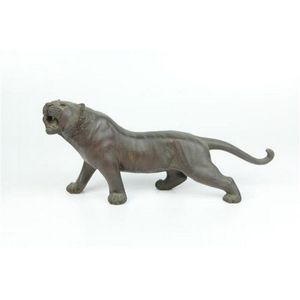Meiji Period Bronze and Spelter Tiger Sculptures
A large Japanese bronze tiger, plus one other in spelter, Meiji period, 1868-1912, a roaring tiger in a matt finish with pronounced polished stripes, signed to, cartouche on belly, plus other similar, height 21.5 cm width 44 cm and smaller
You must be a subscriber, and be logged in to view price and dealer details.
Subscribe Now to view actual auction price for this item
When you subscribe, you have the option of setting the currency in which to display prices to $Au, $US, $NZ or Stg.
This item has been sold, and the description, image and price are for reference purposes only.
- Bronze - An alloy of copper and tin, traditionally in the proportions of about 9 parts of copper to 1 part of tin.
The discovery of bronze in Western Asia in the 4th century enabled people to create metal objects which were superior to those previoulsy possible because of its strength and hardness, and it has been used throughout the world for weapons, coins, tools, statuary and other decorative items.
It is very fluid in a molten state, and its hardness, strength when set, and non-corrosive properties makes it most suitable for casting sculpture. - Spelter - Spelter was the name given to an alloy of zinc and brass or copper used in the 19th century for statuary and lighting. It is a brittle bluish-white metal. It was used as a cheap replacement for bronze, but being brittle easily breaks and can't be repaired. When finished it can often be mistaken for bronze, but if discreet a scratch on the base displays shows a greyish colour, the metal is spelter, if a golden colour the metal is most likely bronze.
- Cartouche - An ornamental panel in the form of of a shield, oval or rectangular scroll with curling edges. It may be carved into the back of a chair or the top of a sideboard, or present on a piece of silver or jewellery, and contain the initials of the original owner, heraldic symbols, or some other inscription, such as the details of a presentation.
In ceramics the term defines the central area of a vase or similar with a decorative border in one of the shapes above, into which a decorative scene or figures have been painted.
This item has been included into following indexes:
Visually similar items

A bronze sculpture of a prowling tiger, Japanese Meiji/Taisho Period, circa 1920, signed, 23 cm high, 50 cm long
Sold by
in
for
You can display prices in $Au, $US, $NZ or Stg.

A Meiji Japanese bronze tiger. 13 cm high, 23 cm wide.
Sold by
in
for
You can display prices in $Au, $US, $NZ or Stg.

Japanese bronze tiger figure modelled in a domineering pose, stamped to the underside. Length 32 cm
Sold by
in
for
You can display prices in $Au, $US, $NZ or Stg.

Japanese bronze tiger figure modelled in a domineering pose, stamped to the underside. Length 43 cm
Sold by
in
for
You can display prices in $Au, $US, $NZ or Stg.
